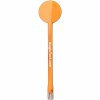Hi!
I'm working on a project that requires the use of a capacitive force sensor like this one:
https://www.singletact.com/micro-force-sensor/standard-sensors/15mm-45newton/
I've broken the problem down into 3 parts, where Part II builds off of Part I, and Part III builds off of Part II.
Part I
If a force of 1.3 lbs or more is applied to the sensor, then a digital numeric display (7-segment display, for example) begins to count up from zero. (It's counting the time that has passed, so after one second it displays "1", after two seconds it displays "2", and so on.)
The digital numeric display continues to count up indefinitely until the force applied to the sensor is 1.0 lbs or less. If the force applied to the sensor is 1.0 lbs or less, then the digital numeric display shows "0" or is blank (either is fine).
The circuit is free to cycle between these two states, where State 1 is when the digital numeric display is counting up, and State 2 is when the digital numeric display is showing "0" or is blank.
Part II
Instead of instantly changing states upon meeting the associated force requirement, any change in state is delayed by 10 seconds.
For example, if the circuit is currently in State 1 (the digital numeric display is counting up) and the force applied to the sensor drops to 1.0 lbs, then the circuit will change to State 2 (the digital numeric display shows "0" or is blank) 10 seconds later.
Part III
In order for the change in state to be successful, the force applied to the sensor must remain within the associated force range requirement over the course of the 10 seconds.
For example, let's say the circuit is currently in State 1. The force applied to the sensor drops to 1.0 lbs and triggers the start of the 10-second delay. The force applied to the sensor varies between 0 lbs and 1.0 lbs for 5 seconds. At this time, a force of 1.1 lbs is momentarily applied to the sensor. Because the 1.1 lbs force is outside of the force range requirement, the change-of-state sequence is aborted. Immediately following the 1.1 lbs force spike, the force applied to the sensor drops back down to 1.0 lbs and the 10-second delay restarts (at zero).
I'm fairly confident that this can be solved without using an Arduino, and instead with using only fundamental electrical components and simple ICs. However, all ideas are welcome
Thanks in advance!
I'm working on a project that requires the use of a capacitive force sensor like this one:
https://www.singletact.com/micro-force-sensor/standard-sensors/15mm-45newton/
I've broken the problem down into 3 parts, where Part II builds off of Part I, and Part III builds off of Part II.
Part I
If a force of 1.3 lbs or more is applied to the sensor, then a digital numeric display (7-segment display, for example) begins to count up from zero. (It's counting the time that has passed, so after one second it displays "1", after two seconds it displays "2", and so on.)
The digital numeric display continues to count up indefinitely until the force applied to the sensor is 1.0 lbs or less. If the force applied to the sensor is 1.0 lbs or less, then the digital numeric display shows "0" or is blank (either is fine).
The circuit is free to cycle between these two states, where State 1 is when the digital numeric display is counting up, and State 2 is when the digital numeric display is showing "0" or is blank.
Part II
Instead of instantly changing states upon meeting the associated force requirement, any change in state is delayed by 10 seconds.
For example, if the circuit is currently in State 1 (the digital numeric display is counting up) and the force applied to the sensor drops to 1.0 lbs, then the circuit will change to State 2 (the digital numeric display shows "0" or is blank) 10 seconds later.
Part III
In order for the change in state to be successful, the force applied to the sensor must remain within the associated force range requirement over the course of the 10 seconds.
For example, let's say the circuit is currently in State 1. The force applied to the sensor drops to 1.0 lbs and triggers the start of the 10-second delay. The force applied to the sensor varies between 0 lbs and 1.0 lbs for 5 seconds. At this time, a force of 1.1 lbs is momentarily applied to the sensor. Because the 1.1 lbs force is outside of the force range requirement, the change-of-state sequence is aborted. Immediately following the 1.1 lbs force spike, the force applied to the sensor drops back down to 1.0 lbs and the 10-second delay restarts (at zero).
I'm fairly confident that this can be solved without using an Arduino, and instead with using only fundamental electrical components and simple ICs. However, all ideas are welcome
Thanks in advance!

